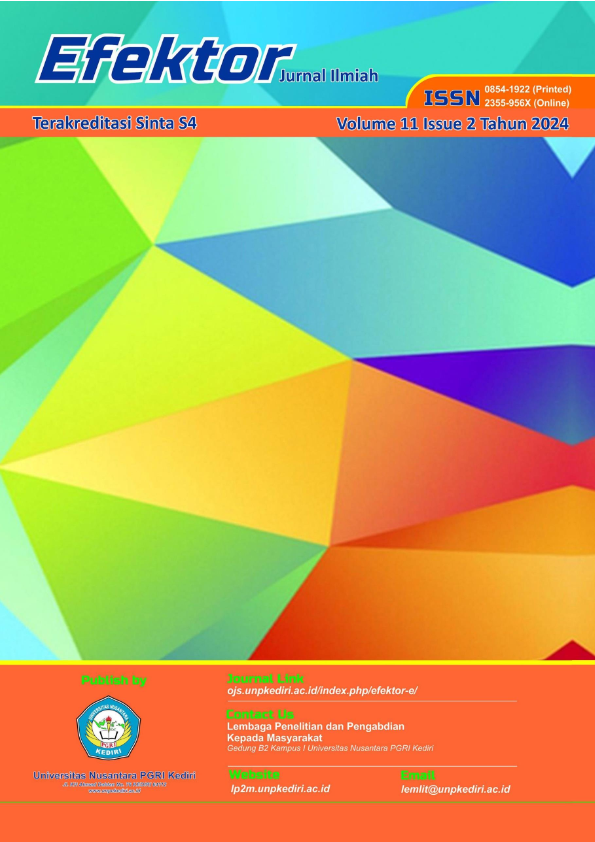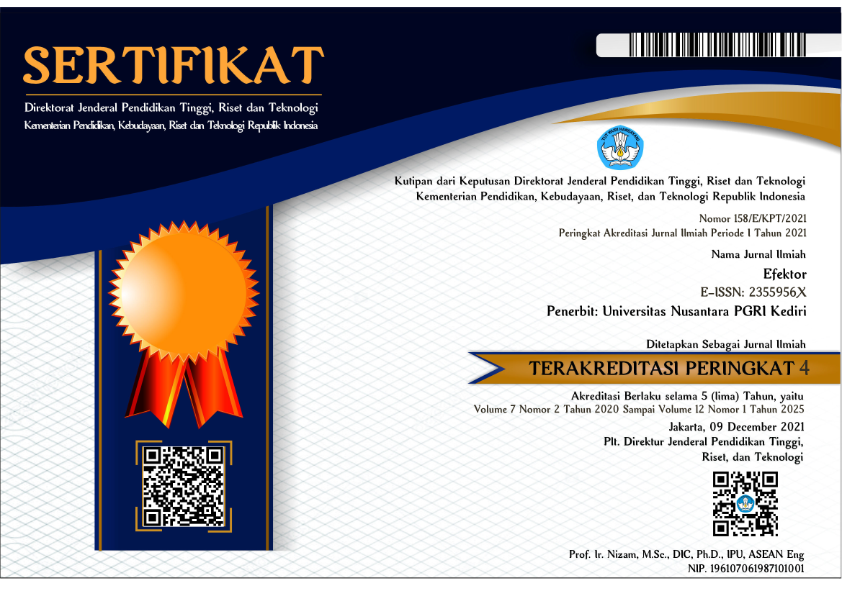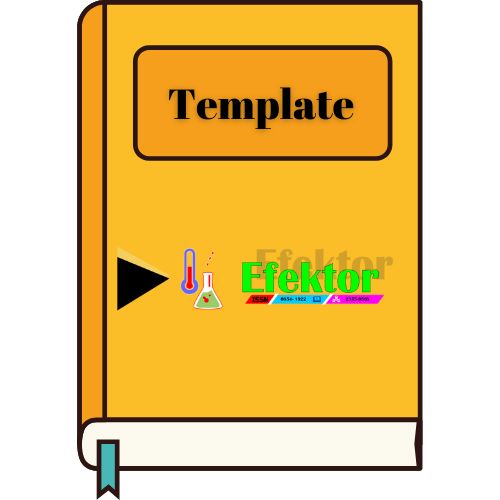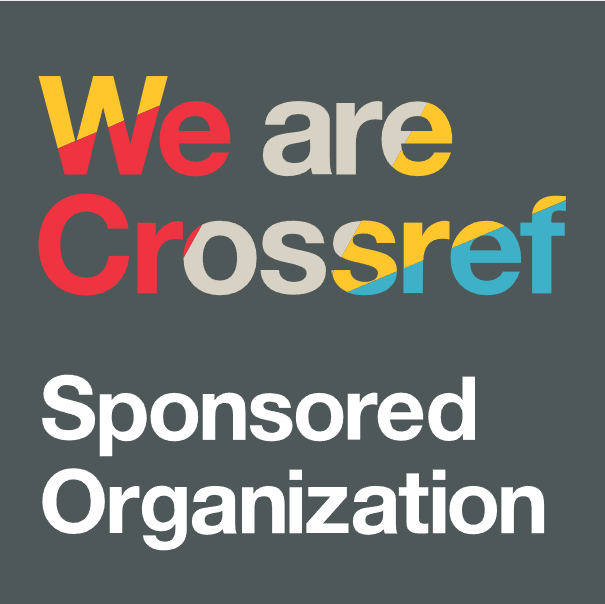he Effort of Improving Numeracy Skills of Early Childhood with Collaborative Learning Method for 5-6 Years old at TK Darut Tauhid Balung
DOI:
https://doi.org/10.29407/e.v11i2.23449Keywords:
kemampuan numerasi, metode kolaboratif, anak usia diniAbstract
One of the most important aspects of everyday life is numeracy. Increasing children's numerical abilities at an early age will have a positive impact on their academic abilities later in life. The aim of this research is an effort to improve the numeracy skills of early childhood children aged 5-6 years at Darut Tauhid Kindergarten. This research uses the classroom action research (PTK) method with the Kemmis and Mc Taggart model which consists of four steps, namely planning, implementation, observation and reflection. Data analysis uses qualitative descriptive analysis techniques. The criteria for research success is increasing numeracy skills in children aged 5 to 6 years, if it reaches a minimum of 71% of children developing as expected or developing very well. Based on the results of the actions, it can be concluded that children's numeracy abilities increase with each cycle. This is proven by an increase in the percentage of children's numeracy abilities from 60% with a total of 12 children in the category developing according to expectations and developing very well in cycle I, increasing in cycle II by 80% with a total of 16 children in the same category. This shows that collaborative learning methods are effective when applied during learning, especially to improve the numeracy skills of early childhood.
References
Amriani, S. R., & Halifah, S. (2024). Pengaruh Model Pembelajaran Kolaboratif terhadap Kecerdasan Interpersonal Anak Usia Dini. Lectura: Jurnal Pendidikan Anak Usia Dini, 7(2), 24–37. https://doi.org/10.31849/paud-lectura.v
Arissaputra, T. M. A. (2023). 3 Metode untuk Meningkatkan Kemampuan Numerasi di Era Digital. Retrieved from https://guruinovatif.id/artikel/3-metode-untuk-meningkatkan-kemampuan-numerasi-siswa-di-era-digital. Diakses 2024
Azis, N. (2018). Pengaruh Media Pembelajaran Huruf Berwarna Terhadap Hasil Belajar Bahasa Indonesia Siswa Tentang Menulis Kalimat Sederhana Pada Kelas 1 SD Inpres Bontomanai Kecamatan Tamalate Kota Makassar. Jurnal Kajian Pendidikan, 6, 45.
Fatimatuzza’rah, S., Habibi, M. A. M., Astawa, I. M. S., & Rachmayani, I. (2022). Penggunaan Kartu Kata Bergambar Untuk Meningkatkan Kemampuan Mengenal Huruf Anak Usia 4-5 Tahun Di Paud Samara Lombok Tahun Ajaran 2020/2021. Jurnal Mutiara Pendidikan, 2(1), 8–13. https://doi.org/10.29303/jmp.v2i1.3533
Fitria, D., Friska, N., & Sukmawarti, S. (2023). Strategi Guru Mengembangkan Kemampuan Numerasi Awal Anak di TK Tabarak Deli Tua. Jurnal Usia Dini, 9(2), 273. https://doi.org/10.24114/jud.v9i2.52450
Husain, R. (2020). Penerapan Model Kolaboratif Dalam Pembelajaran Di Sekolah Dasar. E-Prosiding Pascasarjana Universitas Negeri …, 1(2012), 12–21. Retrieved from http://ejurnal.pps.ung.ac.id/index.php/PSI/article/download/396/359
Kemendikbudristek. (2021). Modul Literasi Numerasi Di Sekolah Dasar. Jakarta.
Panjaitan, W. A., & dkk. (2020). Upaya Meningkatkan Hasil Belajar Siswa Menggunakan Model Pembelajaran Discovery Learning di Sekolah Dasar. Jurnal Basicedu, 4(4), 1350–1357. https://doi.org/10.31004/basicedu.v4i4.549
Permana dkk. (2020). Model Pembelajaran Kolaboratif Meningkatkan Hasil Belajar Matematika Siswa. Jurnal Pedagogi Dan Pembelajaran, 3(2), 223. https://doi.org/10.23887/jp2.v3i2.26552
Prameswara, A. Y., & Pius X, I. (2023). Upaya Meningkatkan Keaktifan dan hasil Belajar Siswa Kelas 4 SDK Wignya Mandala Melalui Pembelajaran Kooperatif. SAPA - Jurnal Kateketik Dan Pastoral, 8(1), 1–9. https://doi.org/10.53544/sapa.v8i1.327
Sulistiyaningsih. (2023). Penerapan pembelajaran numerasi di TK IT Bhakti Insani. Jurnal Pendidikan Anak, 12(2), 186–196. Retrieved from https://journal.uny.ac.id/index.php/jpa/article/view/57318%0Ahttps://journal.uny.ac.id/index.php/jpa/article/download/57318/20586
Talango, S. R. (2020). Konsep Perkembangan Anak Usia Dini. Early Childhood Islamic Education Journal, 1(1), 92–105. https://doi.org/10.54045/ecie.v1i1.35
Trianingsih. (2024). Peningkatan Kemampuan Numerasi Anak TK A Dalam Mengenal Lambang Bilangan 1 – 5 Menggunakan Media Pasir dan Papan Pintar di TK Negeri Pembina Bangsri Trinaningsih. Jurnal Pendidikan Dan Perkembangan Anak, 2(2), 117–125.
Wardhani et al. (2021). Pengembangan Numerasi untuk Anak Usia 3-6 Tahun. Kemendikbudristek by Unicef for Every Child, 1–54. Retrieved from https://paudpedia.kemdikbud.go.id
Winarsih, W. (2022). Peningkatan Kemampuan Pemecahan Masalah Matematika Pada Materi Vektor Menggunakan Model Problem Based Learning Siswa Kelas X Mia Sman 1 Balai Riam Tahun Pelajaran 2021/2022. Meretas: Jurnal Ilmu Pendidikan, 9(1), 64. https://doi.org/10.52947/meretas.v9i1.284
Yusnidah, Y., Siagian, A. F., & Maulana, D. (2023). Efek Model Pembelajaran Kolaboratif Berbasis Masalah Berbantuan Media Livewire Terhadap Kemampuan Literasi Numerasi Siswa. Jurnal Sinestesia, 13(2), 976–984. Retrieved from https://sinestesia.pustaka.my.id/journal/article/view/426
Zahro, I., & Siswono, H. (2023). Upaya Meningkatkan Budaya Literasi Anak Melalui Program “Aku Cinta Buku” di TK Rosella Baru Kabupaten Lumajang. JECIE (Journal of Early Childhood and Inclusive Education), 6(2), 223–231. https://doi.org/10.31537/jecie.v6i2.1176
Zuhaery, M., Dian Hidayati, & Hidayat, M. (2024). Penerapan Ice Breaking dalam proses Pembelajaran sebagai Pengalaman Belajar yang Menyenangkan. Academy of Education Journal, 15(2), 1412–1417. https://doi.org/10.47200/aoej.v15i2.2492
Downloads
Published
Issue
Section
License
Authors who publish with this journal agree to the following terms:
- Copyright on any article is retained by the author(s).
- The author grants the journal, the right of first publication with the work simultaneously licensed under a Creative Commons Attribution License that allows others to share the work with an acknowledgment of the work’s authorship and initial publication in this journal.
- Authors are able to enter into separate, additional contractual arrangements for the non-exclusive distribution of the journal’s published version of the work (e.g., post it to an institutional repository or publish it in a book), with an acknowledgment of its initial publication in this journal.
- Authors are permitted and encouraged to post their work online (e.g., in institutional repositories or on their website) prior to and during the submission process, as it can lead to productive exchanges, as well as earlier and greater citation of published work.
- The article and any associated published material is distributed under the Creative Commons Attribution-ShareAlike 4.0 International License













